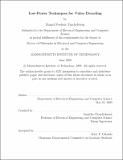Low-power techniques for video decoding
Author(s)
Finchelstein, Daniel Frederic
DownloadFull printable version (4.975Mb)
Other Contributors
Massachusetts Institute of Technology. Dept. of Electrical Engineering and Computer Science.
Advisor
Anantha Chandrakasan.
Terms of use
Metadata
Show full item recordAbstract
The H.264 video coding standard can deliver high compression efficiency at a cost of large complexity and power. The increasing popularity of video capture and playback on portable devices requires that the energy of the video processing be kept to a minimum. This work implements several architecture optimizations that reduce the system power of a high-definition video decoder. In order to decode high resolutions at low voltages and low frequencies, we employ techniques such as pipelining, unit parallelism, multiple cores, and multiple voltage/frequency domains. For example, a 3-core decoder can reduce the required clock frequency by 2.91 x, which enables a power reduction of 61% relative to a full-voltage single-core decoder. To reduce the total memory system power, several caching techniques are demonstrated that can dramatically reduce the off-chip memory bandwidth and power at the cost of increased chip area. A 123 kB data-forwarding cache can reduce the read bandwidth from external memory by 53%, which leads to 44% power savings in the memory reads. To demonstrate these low-power ideas, a H.264/AVC Baseline Level 3.2 decoder ASIC was fabricated in 65 nm CMOS and verified. It operates down to 0.7 V and has a measured power down to 1.8 mW when decoding a high definition 720p video at 30 frames per second, which is over an order of magnitude lower than previously published results.
Description
Thesis (Ph. D.)--Massachusetts Institute of Technology, Dept. of Electrical Engineering and Computer Science, 2009. This electronic version was submitted by the student author. The certified thesis is available in the Institute Archives and Special Collections. Cataloged from student submitted PDF version of thesis. Includes bibliographical references (p. 149-156).
Date issued
2009Department
Massachusetts Institute of Technology. Department of Electrical Engineering and Computer SciencePublisher
Massachusetts Institute of Technology
Keywords
Electrical Engineering and Computer Science.